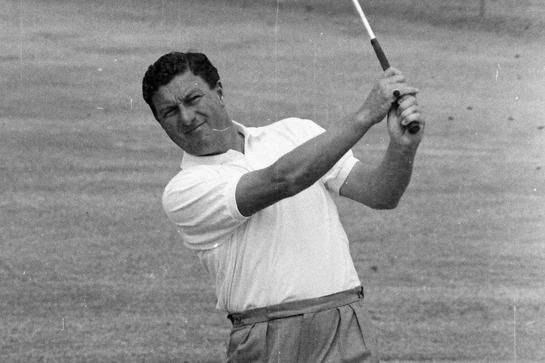Professional golfers possess a distinct understanding of the mechanics underlying effective swings, a crucial aspect of the game. This article analyzes renowned golfer Peter Thomson’s instructional approach, elucidating the principles and techniques he employed to enhance the swing mechanics of his students. By examining Thomson’s insights and methodologies, we aim to provide a comprehensive understanding of the key elements involved in executing a proficient golf swing.
Grip Mechanics and Alignment: Establishing a Solid Foundation
Proper grip mechanics and alignment form the cornerstone of an effective golf swing. Peter Thomson, one of the greatest golfers of all time, emphasized the significance of these elements and outlined specific techniques to achieve optimal execution:
* Grip: Thomson advocated for an “interlocking” grip, where the fingers of one hand are intertwined with those of the other. He believed this method enhanced club control and reduced clubface rotation, leading to improved accuracy and consistency.
Alignment: To establish the proper swing plane, Thomson stressed the importance of ball position relative to the golfer’s stance. He advised using a clock face analogy, with the ball placed at around 10 o’clock for a right-handed golfer and adjusted based on the desired ball flight trajectory. Maintaining parallel feet and perpendicular clubface to the target line ensures a square strike at impact.
Table: Grip Mechanics and Alignment Techniques
| Technique | Description |
|—|—|
| Interlocking Grip | Fingers of one hand intertwined with the other |
| Ball Position | Ball at 10 o’clock for right-handed golfers |
| Parallel Feet | Feet shoulder-width apart and parallel to the target line |
| Perpendicular Clubface | Clubface perpendicular to the target line at impact |
Backswing Analysis: Plane, Tempo, and Leverage
Thomson begins his backswing with the club starting from a neutral position. He keeps his arms relatively straight and swings the club up on a slightly tilted plane that is about parallel to the target line. This allows him to maintain a wide arc and generate maximum power. The speed of Thomson’s backswing is relatively slow and steady, which gives him time to establish a solid base and control his swing. As he swings the club back, he engages his legs and hips to create leverage, which increases his power and efficiency.
Body Cues:
- Arms: Maintain relatively straight while swinging the club up.
- Body: Rotate your hips and legs to create leverage.
- Head: Keep your head steady and centered.
- Shoulders: Rotate your shoulders so that your left shoulder moves under your chin at the top of the backswing.
- Feet: Plant your feet firmly and distribute your weight evenly.
Technical Analysis:
| Swing Phase | Plane | Tempo | Leverage |
|—|—|—|—|
| Backswing | Tilted plane parallel to target line | Slow and steady | Engages legs and hips |
Downswing and Impact: Transferring Power and Precision
During the downswing, Thomson emphasizes transferring power from his upper to his lower body through the ground. The key to this power transfer is maintaining a stable and balanced foundation, with the lower body leading the movement. As the club descends, Thomson initiates a gradual weight shift towards the target, keeping his right knee flexed and left leg extended. This weight shift creates a powerful platform from which to generate force.
At impact, Thomson focuses on striking the ball with precision and control. He makes contact with the ball at the lowest point of the swing arc, ensuring a crisp and solid connection. His grip remains firm and his wrists firm, allowing for maximum stability and accuracy.
To enhance his impact precision, Thomson incorporates a technique known as “delaying the hit”. Instead of aggressively hitting the ball, he momentarily pauses his swing just before impact, allowing the club head to catch up and make contact with the ball’s exact center. This technique promotes a consistent and penetrating ball flight.
The Importance of the Finishing Position: Balance and Clubhead Control
The concluding phase of the golf swing, the finishing position, plays a crucial role in achieving both balance and clubhead control.
Balance: A stable finishing position ensures that the golfer maintains their balance at the end of the swing, preventing them from falling forward or swaying back. By properly shifting their weight to their lead leg and extending their back knee, golfers can create a solid base and prevent themselves from losing their equilibrium. The resulting balance allows for greater precision and accuracy in shot execution.
Clubhead Control: The finishing position also governs the direction and trajectory of the clubhead at impact. By squaring the clubface at contact and maintaining a neutral wrist position, golfers ensure that the ball travels in the intended direction with the desired spin. Additionally, a controlled follow-through prevents the club from decelerating or flipping at impact, resulting in more consistent and powerful shots.
| Importance of Finishing Position | Consequences of Poor Finishing Position |
|---|---|
| Balance | Falling forward or backward |
| Clubhead Control | Misaligned clubface and improper spin |
| Consistency | Inconsistent shot outcomes and reduced distance |
Troubleshooting Common Swing Errors and Refinement Strategies
Troubleshooting Common Swing Errors: As we dive deeper into the mechanics of Peter Thomson’s swing, it’s important to address the potential errors that can impede your progress. Here are a few recurring swing errors to look out for and strategies to address them:
- Casting the Club: This occurs when the player’s hands and club move prematurely forward, resulting in a loss of control and accuracy. To correct, focus on keeping the clubface square and lagging the wrist flexion behind the body rotation.
- Over-the-Top Swing: This error is characterized by the club moving outside-in on the downswing, resulting in a slice or pull. To resolve, ensure that the club swings on an inside-out plane and that the shoulders rotate correctly.
- Swaying or Sliding: Excessive lateral movement can destabilize the swing and lead to inconsistent shots. To address swaying, maintain a stable base and rotate around a solid axis, while for sliding, focus on keeping the weight centered over the feet.
Refinement Strategies: To enhance your golf swing and achieve greater consistency, consider incorporating the following refinement strategies:
- Videotaping Your Swing: Capture your swing on video to identify areas for improvement. Study the footage thoroughly and analyze the key checkpoints of your mechanics.
- Working with a Golf Coach: Enlisting the guidance of a qualified coach can provide expert feedback and personalized drills to accelerate your progress.
- Consistent Practice: Regular and focused practice is crucial for ingraining proper swing mechanics and developing muscle memory.
| Drill | Benefits |
|---|---|
| One-Arm Swings | Isolate specific swing components |
| Mirror Drills | Enhance swing awareness |
| Alignment Sticks | Check swing path and clubface position |
This article has expounded on the effective swing mechanics employed by Peter Thomson, one of golf’s most celebrated champions. Through a detailed examination of his swing, we have gained valuable insights into the key components that contribute to an optimal golf swing. These include proper grip, posture, alignment, backswing, downswing, and follow-through. By emulating the mechanics of a master like Thomson, golfers of all levels can enhance their swing technique and improve their overall performance on the course.





